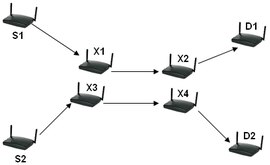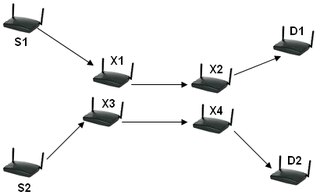
Intra-flow interference is interference between intermediate routers sharing the same flow path.

Intra-flow interference is interference between intermediate routers sharing the same flow path.
In wireless routing, routing protocol WCETT, [1] MIC [2] and iAWARE [3] incorporate consideration to the intra-flow interference metric.

Digital Enhanced Cordless Telecommunications (DECT) is a cordless telephony standard maintained by ETSI. It originated in Europe, where it is the common standard, replacing earlier standards, such as CT1 and CT2. Since the DECT-2020 standard, it also includes IoT communication.
IEEE 802.15 is a working group of the Institute of Electrical and Electronics Engineers (IEEE) IEEE 802 standards committee which specifies Wireless Specialty Networks (WSN) standards. The working group was formerly known as Working Group for Wireless Personal Area Networks.

IEEE 802.11 is part of the IEEE 802 set of local area network (LAN) technical standards, and specifies the set of medium access control (MAC) and physical layer (PHY) protocols for implementing wireless local area network (WLAN) computer communication. The standard and amendments provide the basis for wireless network products using the Wi-Fi brand and are the world's most widely used wireless computer networking standards. IEEE 802.11 is used in most home and office networks to allow laptops, printers, smartphones, and other devices to communicate with each other and access the Internet without connecting wires. IEEE 802.11 is also a basis for vehicle-based communication networks with IEEE 802.11p.

A wireless network is a computer network that uses wireless data connections between network nodes. Wireless networking allows homes, telecommunications networks and business installations to avoid the costly process of introducing cables into a building, or as a connection between various equipment locations. Admin telecommunications networks are generally implemented and administered using radio communication. This implementation takes place at the physical level (layer) of the OSI model network structure.

Wi-Fi is a family of wireless network protocols based on the IEEE 802.11 family of standards, which are commonly used for local area networking of devices and Internet access, allowing nearby digital devices to exchange data by radio waves. These are the most widely used computer networks, used globally in home and small office networks to link devices and to provide Internet access with wireless routers and wireless access points in public places such as coffee shops, hotels, libraries, and airports to provide visitors.

A wireless mesh network (WMN) is a communications network made up of radio nodes organized in a mesh topology. It can also be a form of wireless ad hoc network.

The Wi-Fi Alliance is a non-profit organization that owns the Wi-Fi trademark. Manufacturers may use the trademark to brand products certified for Wi-Fi interoperability. It is based in Austin, Texas.
A cognitive radio (CR) is a radio that can be programmed and configured dynamically to use the best channels in its vicinity to avoid user interference and congestion. Such a radio automatically detects available channels, then accordingly changes its transmission or reception parameters to allow more concurrent wireless communications in a given band at one location. This process is a form of dynamic spectrum management.
Wireless sensor networks (WSNs) refer to networks of spatially dispersed and dedicated sensors that monitor and record the physical conditions of the environment and forward the collected data to a central location. WSNs can measure environmental conditions such as temperature, sound, pollution levels, humidity and wind.
In computer networking, linear network coding is a program in which intermediate nodes transmit data from source nodes to sink nodes by means of linear combinations.
A wireless ad hoc network (WANET) or mobile ad hoc network (MANET) is a decentralized type of wireless network. The network is ad hoc because it does not rely on a pre-existing infrastructure, such as routers or wireless access points. Instead, each node participates in routing by forwarding data for other nodes. The determination of which nodes forward data is made dynamically on the basis of network connectivity and the routing algorithm in use.
Multi-user MIMO (MU-MIMO) is a set of multiple-input and multiple-output (MIMO) technologies for multipath wireless communication, in which multiple users or terminals, each radioing over one or more antennas, communicate with one another. In contrast, single-user MIMO (SU-MIMO) involves a single multi-antenna-equipped user or terminal communicating with precisely one other similarly equipped node. Analogous to how OFDMA adds multiple-access capability to OFDM in the cellular-communications realm, MU-MIMO adds multiple-user capability to MIMO in the wireless realm.

In radio, multiple-input and multiple-output (MIMO) is a method for multiplying the capacity of a radio link using multiple transmission and receiving antennas to exploit multipath propagation. MIMO has become an essential element of wireless communication standards including IEEE 802.11n, IEEE 802.11ac, HSPA+ (3G), WiMAX, and Long Term Evolution (LTE). More recently, MIMO has been applied to power-line communication for three-wire installations as part of the ITU G.hn standard and of the HomePlug AV2 specification.
Game theory has been used as a tool for modeling and studying interactions between cognitive radios envisioned to operate in future communications systems. Such terminals will have the capability to adapt to the context they operate in, through possibly power and rate control as well as channel selection. Software agents embedded in these terminals will potentially be selfish, meaning they will only try to maximize the throughput/connectivity of the terminal they function for, as opposed to maximizing the welfare of the system they operate in. Thus, the potential interactions among them can be modeled through non-cooperative games. The researchers in this field often strive to determine the stable operating points of systems composed of such selfish terminals, and try to come up with a minimum set of rules (etiquette) so as to make sure that the optimality loss compared to a cooperative – centrally controlled setting – is kept at a minimum.

In wireless routing, inter-flow interference refers to the interference between neighboring routers competing for the same busy channel.
IEEE 802.11s is a wireless local area network (WLAN) standard and an IEEE 802.11 amendment for mesh networking, defining how wireless devices can interconnect to create a wireless LAN mesh network, which may be used for relatively fixed topologies and wireless ad hoc networks. The IEEE 802.11s task group drew upon volunteers from university and industry to provide specifications and possible design solutions for wireless mesh networking. As a standard, the document was iterated and revised many times prior to finalization.
A mobile wireless sensor network (MWSN) can simply be defined as a wireless sensor network (WSN) in which the sensor nodes are mobile. MWSNs are a smaller, emerging field of research in contrast to their well-established predecessor. MWSNs are much more versatile than static sensor networks as they can be deployed in any scenario and cope with rapid topology changes. However, many of their applications are similar, such as environment monitoring or surveillance. Commonly, the nodes consist of a radio transceiver and a microcontroller powered by a battery, as well as some kind of sensor for detecting light, heat, humidity, temperature, etc.

Victor Bahl is an American Technical Fellow and CTO of Azure for Operators at Microsoft. He started networking research at Microsoft. He is known for his research contributions to white space radio data networks, radio signal-strength based indoor positioning systems, multi-radio wireless systems, wireless network virtualization, edge computing, and for bringing wireless links into the datacenter. He is also known for his leadership of the mobile computing community as the co-founder of the ACM Special Interest Group on Mobility of Systems, Users, Data, and Computing (SIGMOBILE). He is the founder of international conference on Mobile Systems, Applications, and Services Conference (MobiSys), and the founder of ACM Mobile Computing and Communications Review, a quarterly scientific journal that publishes peer-reviewed technical papers, opinion columns, and news stories related to wireless communications and mobility. Bahl has received important awards; delivered dozens of keynotes and plenary talks at conferences and workshops; delivered over six dozen distinguished seminars at universities; written over hundred papers with more than 65,000 citations and awarded over 100 US and international patents. He is a Fellow of the Association for Computing Machinery, IEEE, and American Association for the Advancement of Science.

IEEE 802.11be, dubbed Extremely High Throughput (EHT), is the latest of the IEEE 802.11 standard, which is designated Wi-Fi 7. It has built upon 802.11ax, focusing on WLAN indoor and outdoor operation with stationary and pedestrian speeds in the 2.4, 5, and 6 GHz frequency bands.

Zygmunt J. Haas is a professor and distinguished chair in computer science, University of Texas at Dallas (UTD) also the professor emeritus in electrical and computer engineering, Cornell University. His research interests include ad hoc networks, wireless networks, sensor networks, and zone routing protocols.